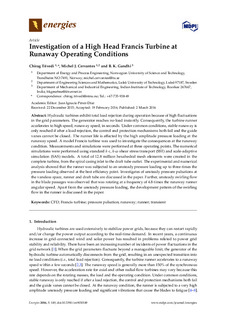| dc.description.abstract | Hydraulic turbines exhibit total load rejection during operation because of high fluctuations
in the grid parameters. The generator reaches no-load instantly. Consequently, the turbine runner
accelerates to high speed, runaway speed, in seconds. Under common conditions, stable runaway is
only reached if after a load rejection, the control and protection mechanisms both fail and the guide
vanes cannot be closed. The runner life is affected by the high amplitude pressure loading at the
runaway speed. A model Francis turbine was used to investigate the consequences at the runaway
condition. Measurements and simulations were performed at three operating points. The numerical
simulations were performed using standard k-", k-! shear stress transport (SST) and scale-adaptive
simulation (SAS) models. A total of 12.8 million hexahedral mesh elements were created in the
complete turbine, from the spiral casing inlet to the draft tube outlet. The experimental and numerical
analysis showed that the runner was subjected to an unsteady pressure loading up to three-times the
pressure loading observed at the best efficiency point. Investigates of unsteady pressure pulsations at
the vaneless space, runner and draft tube are discussed in the paper. Further, unsteady swirling flow
in the blade passages was observed that was rotating at a frequency of 4.8-times the runaway runner
angular speed. Apart from the unsteady pressure loading, the development pattern of the swirling
flow in the runner is discussed in the paper. | nb_NO |
